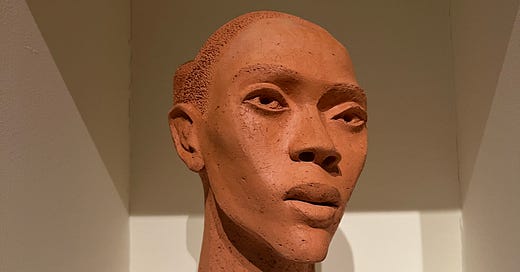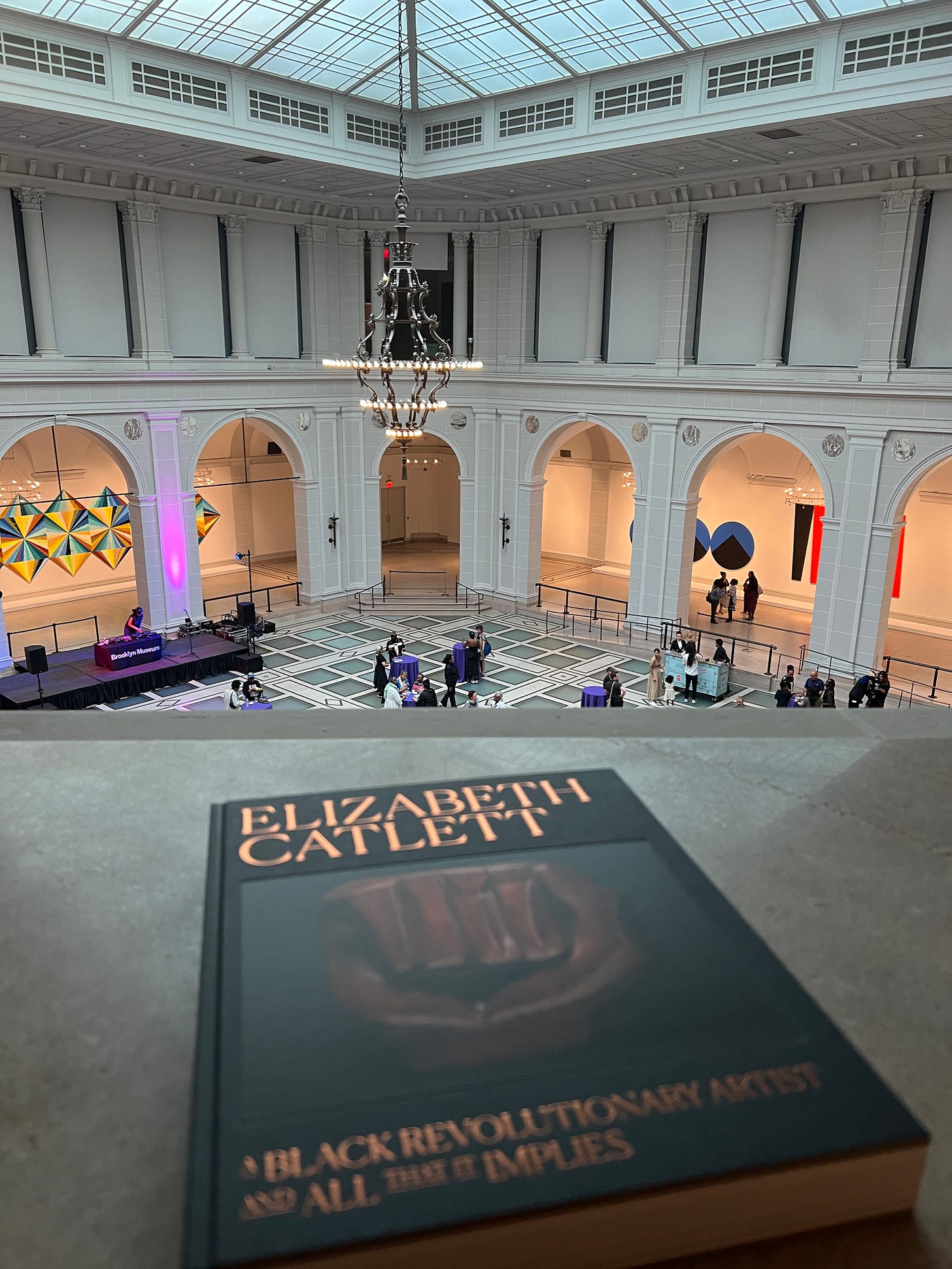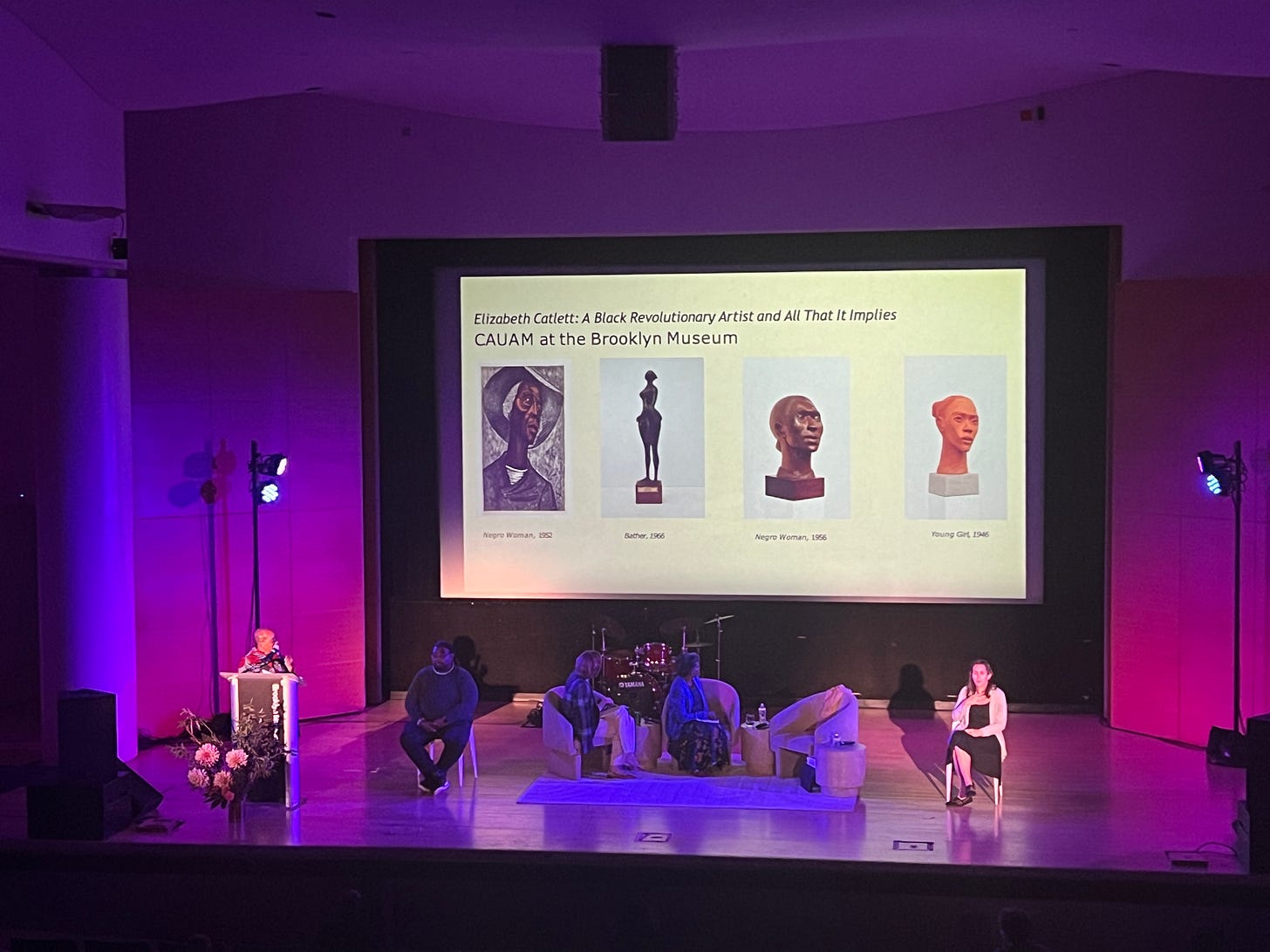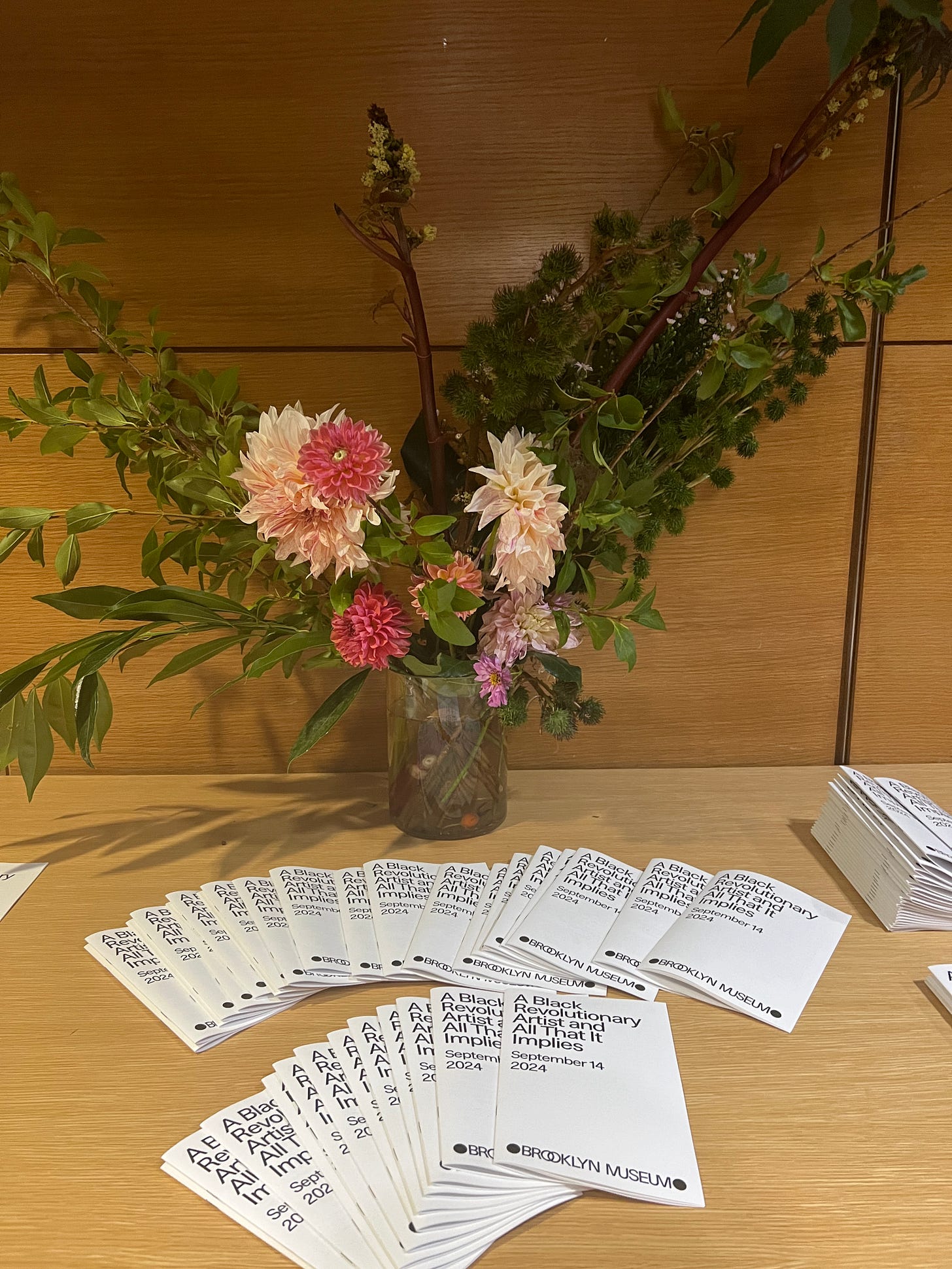(Photo by me: Elizabeth Catlett: A Black Revolutionary Artist and All That It Implies, Edited by Dalila Scruggs, on the ledge overlooking Beaux-Arts Court)
There are some artists that you just have a spiritual connection with. Elizabeth Catlett is one of those artists for me. Not only does she remind me of my maternal great grandmother in terms of physical looks, she is also an inspiration for the incredible life that she lived during a time when her experiences and opportunities were unheard for Black women. I do not remember the first time that I encountered her work, but I have been captivated by it ever since.
(Me in front of the exhibition opening captured by Nia Mora)
When first encountering her work, I did not realize what a robust life she led in addition to her artistic practice. Born in 1915 in Washington D.C., she eventually became a Howard University art professor teaching alongside contemporaries such as Augusta Savage and was even married to the artist, Charles White, during this period.
Thanks for reading! Subscribe for free to receive new posts and support my work.
Then, she escaped to Mexico during the McCarthy Era, joined the Taller de Gráfica Popular and settled with a Mexican artist Francisco Mora whom she married and would go on to create a multicultural, multidisciplinary and multifaceted family. In fact, one of her granddaughters was one of my favorite contestants on America’s Next Top Model, Naima Mora.
Curator Dalila Scruggs describes Catlett as a “social realist printmaker and sculptor employing a vocabulary of organic abstraction.” Her work spanned decades crossing pivotal cultural historical moments from Jim Crow era segregation all the way to the Obama era. Throughout it all, she remained a Black revolutionary artist working primarily in sculpture and printmaking.
(Photo by me: Self Portrait, Elizabeth Catlett, 1999).
The exhibition at the Brooklyn Museum gets its title from a speech that Catlett gave to the Conference on the Functional Aspects of Black Art (CONFABA) for which she was denied entrance into the United States as a “foreigner” from Mexico (despite being American-born) to attend. Instead, she spoke from a telephone and uttered these rallying words: “For I have been, and am currently, and always hope to be a Black Revolutionary Artist, and all that it implies!”
(Photo by me: Young Girl, Elizabeth Catlett, 1946)
Upon learning about Catlett’s transformational move to Mexico, I was immediately reminded of my own transformative experience in Mexico City albeit under fundamentally different circumstances. I was a tourist on the one hand and Catlett was an exiled artist activist. It was so mindblowing to learn about what a groundbreaking move this was for a Black woman at this point in history because we do not often learn about Black women taking a leap of faith to go to a country where they have likely never been and do not speak the language. In this way, her journey was so inspiring to me as someone who loves to travel and immerse herself in other cultures. It reminds me of other Black women (intentionally hidden figures) that reoriented their lives outside of the United States like one of my heroines, Josephine Baker who was also a revolutionary in France in the 1920s-1930s and even later with artists/activists Maya Angelou and Nina Simone in West Africa in the 1960s and 1970s.
(Photo by me: Legacies of Support: Historically Black Colleges and Universities Collecting Elizabeth Catlett panel featuring Danille Taylor, Vanessa Thaxton-Ward and Catherine Morris)
In celebration of the opening of Elizabeth Catlett: A Black Revolutionary Artist and All That It Implies exhibit at the Brooklyn Museum, the museum hosted a symposium that explored the life and legacy of Elizabeth Catlett. Included in the line-up of the prominent art historians, curators, museum leaders and artists were Linda Goode Bryant, Lowery Stokes Sims, Dalila Scruggs, Melanie Herzog and Catlett’s son Francisco Mora Catlett among many other names who gave personal insights or important context to Catlett’s work. I wish I would have recorded more content during the symposium because there were so many nuggets of information about Catlett’s process and her ethos on the creativity of life. Here were some little snippets that I did manage to write down that gave me moments of inspiration:
“The physicality of Black women’s poses and existence”
“Sometimes there’s just a feeling that goes unspoken”
“Elizabeth’s work when you find it won’t let you go”
“Scholarship needs to be continuously done because we have to update the history”
“Only the full liberation of Black people will make the development of Black art”
“Africa taught Mora to see color”
(Photo by me of the symposium program)
Just walking around the exhibit you can truly get a sense of how ardent an advocate Catlett was for the plight of Black womanhood in the U.S. This is also reflected in the fact that most of the objects in the show are on loan from HBCUs which is unfortunately rare for such a monumental collection given the institutional racism baked into the art world’s collecting and archiving practices. Catlett made a point to gift many of her life’s works primarily to HBCU’s. She stated in her Rosenwald Fellowship application that: ”It is my earnest desire to portray this history of Negro womanhood in lithography, painting and sculpture , and to send these portrayals to Negro and white colleges so that young men and women, especially in the south, can get some idea of the contributions of Negro American women.”
I implore you to check out this exhibit if you have the privilege passing by the Brooklyn Museum. I will be hosting a meet up on Saturday, November 30th from 12p-2pm if you want to see the show in community!
Until then, I will leave you with this quote from the exhibit:
“I feel that art should be a combined emotional, aesthetic and social expression. Such a project would give me an excellent opportunity for creative expression and development.”
Elizabeth Catlett
Please check out this playlist that is inspired by my thoughts on Catlett’s work:
Thanks for reading! Subscribe for free to receive new posts and support my work.









